Starting university can already feel overwhelming and confusing. Your back-to-back classroom lessons, often led by the same teacher each week, are now replaced by a rotating ensemble of lecturers and seminar tutors. The transition to university-style teaching can feel sudden and daunting, so it’s important to find the best note-taking method for you.
Each note-taking method will be rated out of five on six different criteria:
- Speed (does the method allow you to keep up with fast-paced lectures?)
- Clarity and organisation (are the notes structured logically, ensuring they are easy to read and understand later?)
- Retention (does this method help you remember more after reviewing notes?)
- Easy to review (are the notes easy to skim, highlight, or quiz yourself when studying?)
- Flexibility (can this method be adapted to different types of subjects?)
- Effort to maintain and prepare (how much work is needed to use this method consistently?)
1. Cornell method
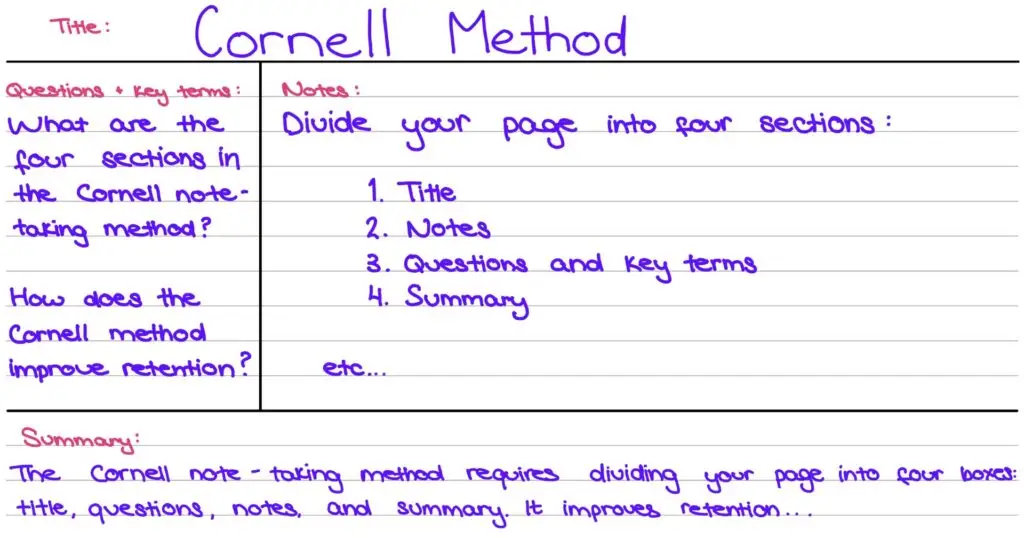
Overall rating: 4/5
The Cornell Method involves dividing your page into four different sections: a box at the top of the page for your title, a small column, a larger column, and a box at the bottom of your page. During your lecture, make your notes in the larger column. After the lecture, fill in the smaller column with keywords and questions. You can use this section for active recall prompts when reviewing your notes. In the bottom box, write a summary of your notes from your larger column.
Speed: 3/5
The Cornell method is a fast note-taking method, as you fill in the main box during your lessons. However, it does require time before and after your lectures/seminars to create the layout and complete the summary box and prompt column.
Clarity and organisation: 4/5
The boxes and columns help organise your notes into clear sections, making them easy to understand later. If you overfill any of the boxes, it can be difficult to read later because your writing can look cramped inside the boxes.
Retention: 5/5
Actively summarising your class notes will give you a better understanding of a topic, as you’ll be forced to choose and reword important information from your notes. Also, writing the prompts will further help you to extract key points from a topic.
Easy to review: 5/5
Cornell notes are perfectly formatted for revision. The summaries can be used to refresh your memory on a topic, and the prompt column can be used for active recall.
Flexibility: 3.5/5
The Cornell note-taking method can be used for most seminars and lectures, but it is not useful for those who need to memorise a lot of facts (i.e. languages, definitions) because of the limited space on the page. This method might not be suited to those who prefer visualising their information or for those who need space for diagrams.
Effort to maintain: 3.5/5
This method requires a blank page with the boxes to be prepared before every seminar/lecture, which can be time-consuming. If you are working digitally, you can just duplicate your pages with the layout. If you prefer working on paper, you can scan a page with the layout and print out multiple copies. Also, the Cornell method does require extra time to write the summaries and prompts.
2. Boxing method
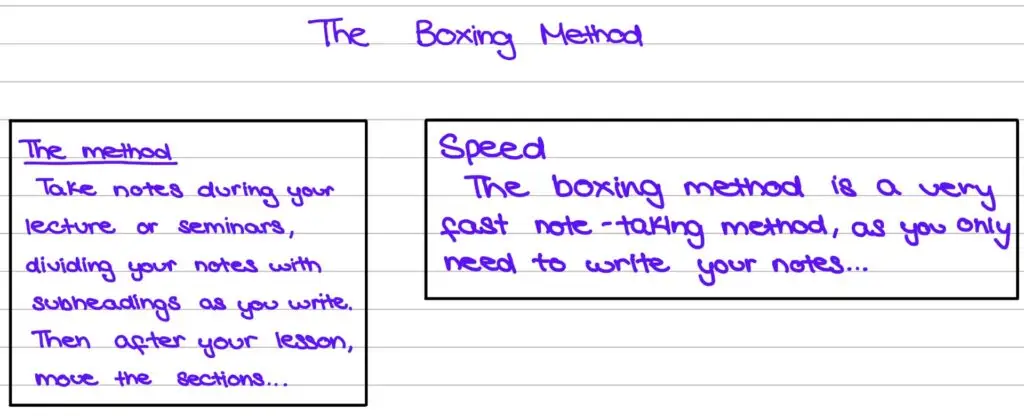
Overall rating: 3.5/5
The boxing method is mainly compatible for those who write the notes digitally. The method begins with you taking notes during your lectures or seminars, dividing your notes into sections with headings as you write. Then, after your lesson, move the sections around your page. Once you are happy with the layout, create a box for each section using a shape tool.
Speed: 4/5
The boxing method is a very fast note-taking method, as you only need to write your notes as you normally would before dividing them into separate sections. Furthermore, dividing your notes into separate boxes will be easy if you use subheadings while writing.
Clarity and organisation: 4/5
The boxes will help keep the different topics in your notes separate, ensuring that they are easy to read. You could also colour-code your notes to help distinguish between the topics and subheadings. If you’re a visual learner, having your topics separate and colour-coded could help you remember and recall information.
Retention: 3/5
Before organising your notes into boxes, you will need to reread them in order to properly categorise them into sections and summarise your notes so they can fit inside the boxes. This forces you to review your notes and engage with the material more deeply, thereby retaining important information. However,
Easy to review: 4/5
Organising all of you notes into separate boxes will prevent your notes from looking too overwhelming. This structure also allows you to revisit key themes without having to reread all of your notes, meaning that your study sessions are efficient and effective.will make them easier and less overwhelming to look back on.
Flexibility: 3/5
The boxing method can be useful for subjects that only require a rigid overview of a topic, rather than topics that involve multiple connections between ideas. Furthermore, once you’ve created your boxes, it can be hard to expand on any ideas without overcrowding a box or redrawing the layout. This limits the possibility for spontaneous additions or the opportunity to explore links between topics.
Effort to maintain: 4/5
The boxing method doesn’t require any preparation, so you can just make your notes as normal during your lessons. Dividing your notes into different sections is easy if you use headers while actively taking notes during your lessons. Drawing the boxes and choosing the layout is the most challenging part of the boxing method because it requires planning the structure of your content.
3. Outline method
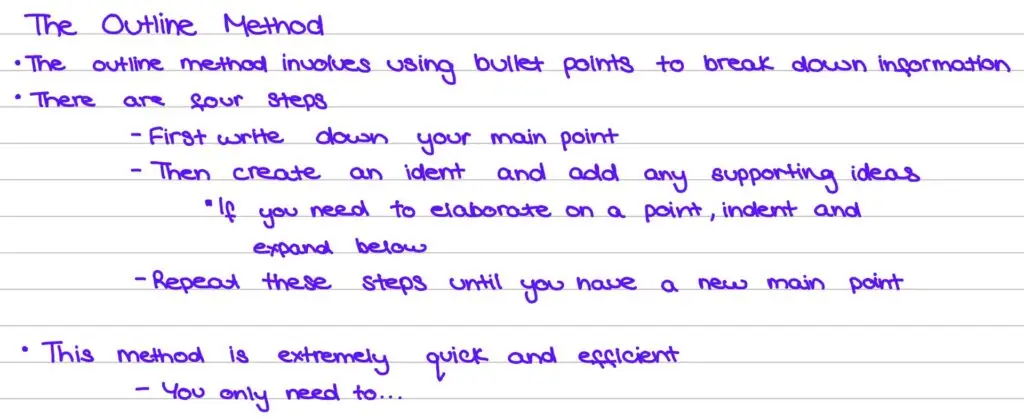
Overall rating: 4/5
The outline method involves using bullet points to break down main points into related ideas. There are four steps in the outline method. First, write down your main point. Then create an indent and add any supporting/related ideas below it. If you need to further elaborate on a point, indent and expand on the point below. Finally, repeat this step until you have a new main point.
Speed:5/5
This method is extremely quick and efficient since you only need to bullet point your main ideas and related points without having to worry about full sentences or extremely detailed explanations at first. You can write down your ideas quickly, allowing you to keep up with any fast-paced seminars or lectures.
Clarity and organisation: 4/5
The outline method is clearly structured with each main point being bullet pointed and broken down into distinct ideas. However, if you have lots of notes and secondary ideas, the page can look very overwhelming.
Retention: 4/5
The outline method helps with retention because the information is broken into manageable chunks or points, making it easier to remember. However, if the secondary ideas lack meaning connection to the primary point, retention may be less effective.
Easy to review: 3/5
Even though the notes can be clearly organised, the layout could still be overwhelming to study from. If you bolden, underline, or highlight your main points your notes could be easier to read. Also, the notes could be difficult to follow if you don’t maintain a consistent level of detail. You should ensure that there is an clear relationship between each main point.
Flexibility: 4/5
This method is extremely flexible. You can easily add or remove points as needed (if making notes digitally), so you can write simple or highly detailed notes depending on the subject. You can insert images and diagrams into your notes but, if your subject heavily relies on visual elements then this method isn’t the most suitable.
Effort to maintain: 5/5
For the outline method you don’t need to do any prep work before your lesson. You can highlight and underline any notes while reviewing your notes.
4. Charting method
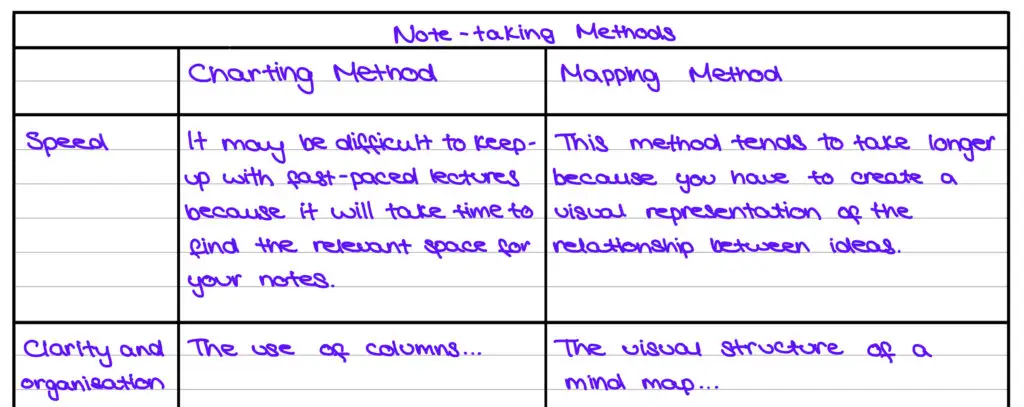
Overall rating: 3/5
The charting method involves dividing your page into columns and rows to create a table. You can then fill in the headers with different topic ideas before your lectures/seminars. To organise your notes into the table you can either make notes directly into the table or add your lecture/seminar notes afterwards.
Speed: 3/5
During your lessons it may take time to find the relevant space for your notes, so it may be difficult to use this structure for fast-paced lectures. However, the table format allows you to efficiently organise all your notes into distinct categories during your lessons. Therefore, instead of writing everything in one long block of text, you can assign new ideas into their assigned spaces, so you don’t have to worry about organising your notes later.
Clarity and organisation: 5/5
The use of columns with dedicated themes ensures that information is clearly separated into distinct sections which is easy to navigate. The layout also breaks up dense content, providing a structured format that reduces confusion and aids comprehension.
Retention: 3/5
Categorising information might make it easier to reference your notes later, but it doesn’t necessarily promote deep learning and memorisation. However, including more detail in your columns or covering up your notes to use your headers as prompts could improve retention.
Easy to review: 4/5
The charting method organises the material in a logical and accessible way. This means that you can locate key concepts and make comparisons without having to sift through large amounts of text. Nevertheless, if you’re table becomes overloaded with too much information, it may become difficult to read.
Flexibility: 3/5
While the charting method is somewhat flexible, it cannot be used for subjects that cannot be easily and neatly categorised. It may be difficult to fit the information into predefined columns, requiring you to adjust the structure during the lecture. Also, if your lecture jumps between topics or provides more nuanced information that doesn’t neatly fit into your table you may need to change the layout.
Effort to maintain: 2.5/5
Before every lesson you need to prepare a new table with specific headers. If, during the lessons, a topic is mentioned which doesn’t fit into any of the sections, you may need to adjust your table. Also, if your lecture jumps between topics it can be difficult to maintain the layout.
5. Mapping method
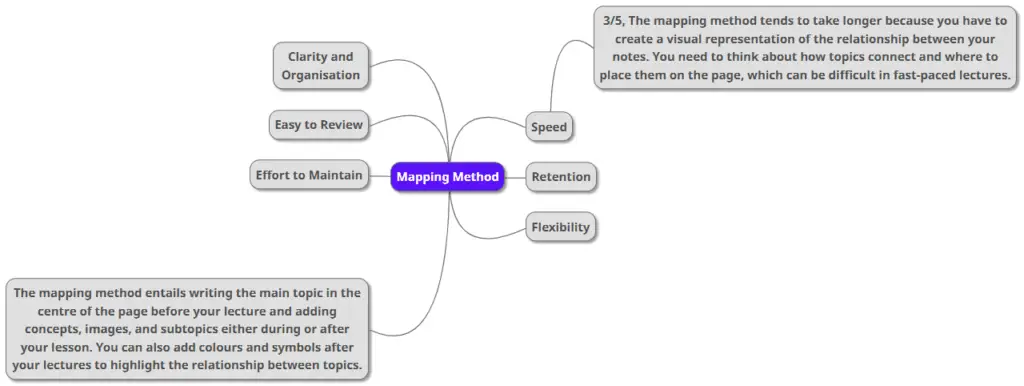
Overall rating: 4/5
The mapping method entails writing the main topic in the centre of the page before your lecture and adding concepts, images, and subtopics either during or after your lesson. You can also add colours and symbols after your lectures to highlight the relationship between topics. A good, free online tool for mapping is MindMup.
Speed: 3/5
The mapping method tends to take longer because you have to create a visual representation of the relationship between your notes. You need to think about how topics connect and where to place them on the page, which can be difficult in fast-paced lectures.
Clarity and organisation: 4/5
The visual structure of a mind map allows you to understand and instantly see how concepts relate to each other. The use of colours, symbols, and images can clarify these relationships and make your notes easier to follow. However, if you do not plan your mind map out correctly, it can become difficult to follow and read.
Retention: 4.5/5
The mapping method promotes better retention because you are organising ideas visually and showing their connection. Mind mapping also requires active engagement with the material as you are analysing the information in order to decide how to structure your map, helping you remember your notes.
Easy to review: 4/5
When you review your mind maps you can quickly trace the relationships between concepts by looking at the lines between ideas or using colour coding. Although, if you’re writing down lots of notes, the page can look crowded making reviewing your notes more difficult. If you keep your mind map organised it will be easy to review.
Flexibility: 4/5
Mapping is highly flexible because it works with all subjects that involve complex and interconnected information. You can easily add new topics to your map as the lecture or seminar progresses and more ideas emerge.
Effort to maintain: 3/5
Maintaining a map can be difficult if you’re trying to make it highly detailed and easy to read. While writing notes you need to constantly adjust the map as new ideas are introduced, which can require a lot of effort. However, as you practice making mind maps, the formatting will come naturally and your notes will be clearer with less effort.
6. Sentence method
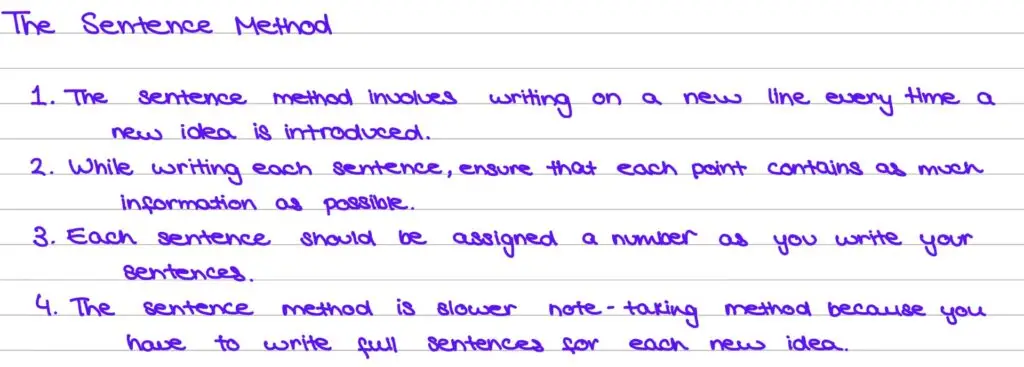
Overall rating: 3/5
The sentence method involves writing on a new line every time a new idea is introduced. While writing each sentence, ensure that each point contains as much information as possible. Each sentence should be assigned a number as you write your sentences.
Speed: 3/5
The sentence method is slower note-taking method because you have to write full sentences for each new idea. This requires more time during the lecture which will be difficult to keep up with in dense and fast-paced lessons.
Clarity and organisation: 2/5
The sentence method can be difficult to follow because each idea is written on a new line. This means that there’s no inherent structure and will leave the content feeling fragmented and hard to reread. The lack of headings of categories makes your notes a disjointed list of information.
Retention: 3/5
Writing full sentences will encourage deeper engagement with the lecture/seminar content, which can improve retention. However, without a clear structure or headings, it can be difficult to establish connections between ideas and main topic ideas, which may hinder retention.
Easy to review: 2/5
The sentence method can be difficult to review because the lack of organisation makes it difficult to locate relevant information. You will have to read through all your notes so that you can piece together the broader themes. The numbered structure could help, but your notes can still be difficult to navigate.
Flexibility: 4/5
The sentence method can be applied to a wide range of subjects and you can adjust your writing style midway through a lesson. You can also include images, diagrams, and graphs easily into your notes because there is no structure to adhere to. However, this format could become too cumbersome and overwhelming if the topic is complex or detailed.
Effort to maintain: 4/5
Maintaining the sentence method is easy because you just need to write new sentences every time a new idea is introduced. The challenge is keeping your sentences concise yet informative, while ensuring not to be too repetitive.
7. Four quarters
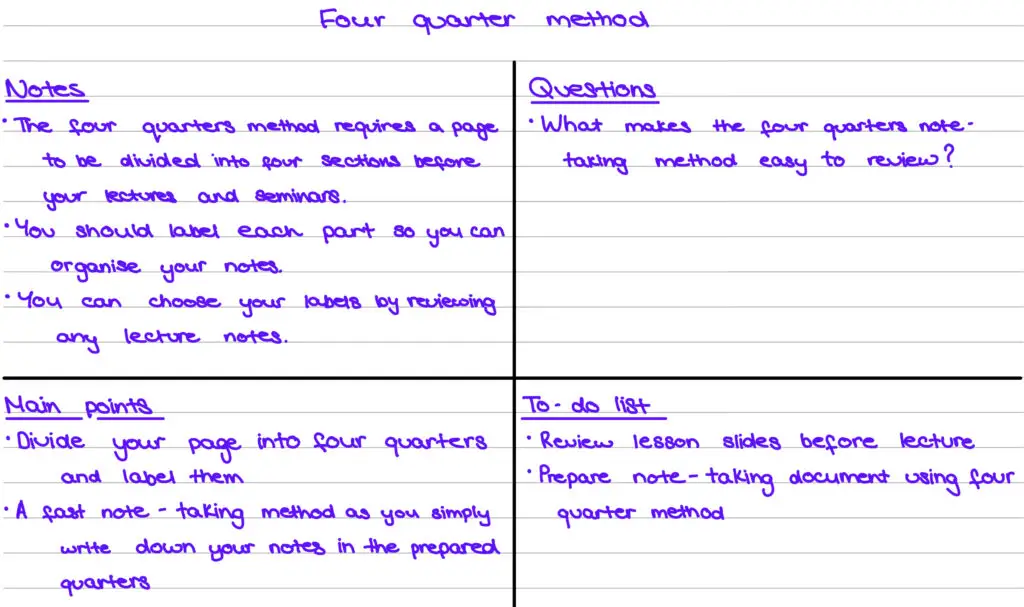
Overall rating: 4/5
The four quarters method requires a page to be divided into four sections before your lecture/seminar. You should also label each part so you can organise your notes (you can choose your labels by reviewing any lecture notes before your lessons). Some generic labels could be ‘questions’, ‘main insights’, ‘personal to-do-list’, and ‘key terms’. During your lessons fill in the quadrants with your notes.
Speed: 4/5
During your lectures or seminars you can simply write down relevant information into your prepared four sections. The section themes will be broader compared to the charting method so you will spend less time having to decide where to put things. The four quarter method is a time-efficient way to organise your notes while still categorising key ideas.
Clarity and organisation: 4/5
By separating your notes into themed sections, you reduce the chance of mixing up your notes. Each quarter serves a specific purpose which ensures your notes are clearly and distinctly organised, which makes it easier to review details while studying.
Retention: 4/5
The four quarters method encourages you to actively engage with the topics which can improve retention. For example, the ‘questions’ section encourages critical thinking and the ‘main insights’ section helps consolidate key takeaways. Also, breaking up the material into meaningful sections allows you to learn the relationship and connections between ideas.
Easy to review: 4/5
Reviewing your notes is easy with the four quarters method because the clear divisions allow you to find and focus on specific types of information quickly. If you need to revisit key terms, simply review your notes in the related section. If you need to reflect on your questions or insights, those are clearly outlined in the relevant quarter.
Flexibility: 3/5
The four quarters method is somewhat flexible since it works well for most traditional lecture formats with a clear structure. Although, this layout might not work as well for subjects that don’t have clear categories or are extremely complex, meaning it could be hard to force every idea into one of the four sections
Effort to maintain: 3/5
Maintaining the four quarters method requires a bit of effort because you need to choose your themes and design the page before lessons. It’s important to choose your categories carefully beforehand. If they are too broad the categories may overlap making it difficult to organise your notes. On the other hand, if they are too narrow some of your notes won’t fit in your predetermined sections.
8. Slide annotation
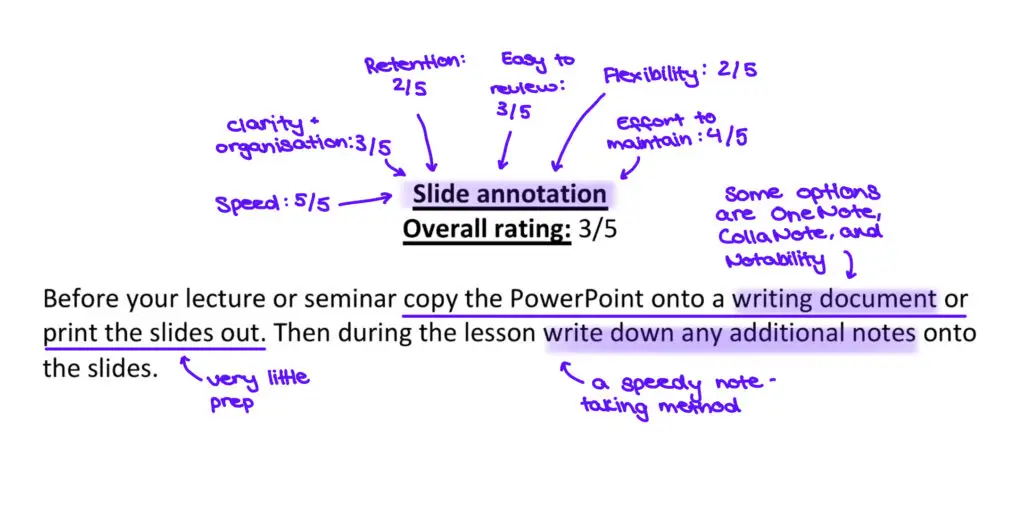
Overall rating: 3/5
Before your lecture or seminar copy the PowerPoint onto a writing document or print the slides out. Then during the lesson write down any additional notes onto the slides.
Speed: 5/5
Slide annotation is fairly quick because you’re working with the slides already provided. You’re not starting with an empty page, so you can focus on adding supplementary notes or explanations. This method saves you the time of having to write everything down verbatim as you can just annotate the key points.
Clarity and organisation: 3/5
While slides offer a good starting point, your annotations may become cluttered if you add too many ideas. If you use colour coding and symbols your notes could be well-organised and a helpful reference. However, if you write too many ideas, the slides can become too cluttered with annotations.
Retention: 2/5
This method doesn’t necessarily enhance retention unless you actively engage with the content you’re annotating after your lessons. Simply writing down extra notes on the slides can help, but it doesn’t guarantee that you’re internalising the material.
Easy to review: 3/5
Reviewing your slide annotations is easy because you have the original slide to help jog your memory. You can see the slides and then refer to your annotations for additional context. However, if you’ve written too much, it may become harder to extract the key points quickly.
Flexibility: 2/5
This method is not very flexible, as it heavily relies on the slides already provided. If your course doesn’t use slides, if the slides are already busy, or if the slides don’t adequately represent the material, this method may not be suitable for you.
Effort to maintain: 4/5
Maintaining slide annotations is easy, as it just requires you to write down extra notes on the slides during the lecture. However, you do need to be mindful of the fact that the slides are pre-structured, so you may need to go over the slides and have a general idea about formatting before lectures.
Hopefully this guide will help you decide which note-taking method will be best for your seminars and lectures. If you’re still unsure about which to choose, you can always test out a few options before making a final decision. Also, check out our list of the best note-taking apps to understand your options!

Topic expertise: Student Cities, Cost of Living, Nightlife, Wellbeing, Accommodation
FAQs on Note Taking — A Student’s Guide
Good notes help you process information during lectures, retain key points, and create a personalised study resource. They save time later by reducing what you need to re-read and help you stay organised throughout term.
Popular methods include Cornell (divide page into cues, notes, summary), mind mapping, outlining (hierarchical bullet points), and charting (tables for comparison). Experiment with formats to find what matches your course and thinking style.
Digital notes offer speed, searchability, and syncing across devices, while handwriting can boost memory and understanding. Some students use hybrid approaches—handwriting in lectures, then digitising and refining later.
Regularly review notes within 24–48 hours, summarise main ideas, and highlight questions. Use headings, colour codes, margin cues, and digital tags to structure your material. Creating a summary sheet helps cement your memory.
Listen for verbal cues (repeat, signpost), write only keywords not everything, leave gaps to fill when reviewing, and use abbreviations/lists. Recording (if allowed) can let you catch missed content later on.
Author
-
Hi, I'm Kirstie! I'm a BA English student at the University of Bristol, with a passion for creative writing. In my free time, I enjoy baking, sewing, and playing the flute.
View all posts


